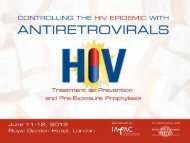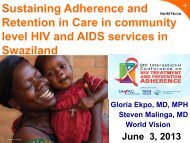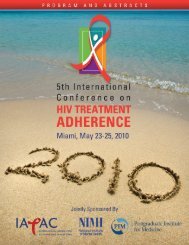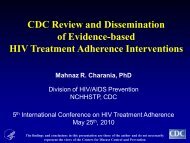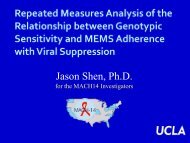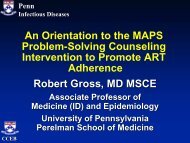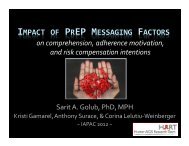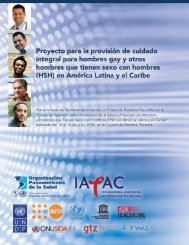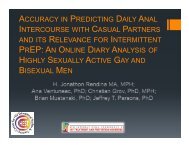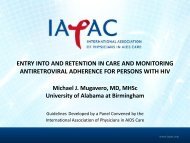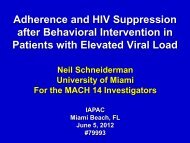PrEP - IAPAC
PrEP - IAPAC
PrEP - IAPAC
Create successful ePaper yourself
Turn your PDF publications into a flip-book with our unique Google optimized e-Paper software.
PSYCHOSOCIAL PREDICTORS OF ACCEPTABILITY<br />
AND RISK COMPENSATION FOR PREP<br />
results from three critical populations<br />
Sarit A. Golub, PhD, MPH<br />
Corina Weinberger, Kristi Gamarel, H. Jonathon Rendina,<br />
Jose Nanin, Jeffrey Parsons<br />
~ <strong>IAPAC</strong> 2012 ~
Thank you<br />
• Jeffrey Birnbaum and the HEAT staff<br />
• NIMH<br />
R01MH095565 (Golub), Willo Pequegnat, PO<br />
R01MH087714 (Parsons), David Stoff, PO<br />
• CDC<br />
U01PS000707 (Nanin), Madeline Sutton, PO<br />
Our amazing team of scientists,<br />
graduate students, and<br />
research staff at CHEST<br />
The participants who gave their<br />
time and energy to these studies
“For me, what it was is like a beautiful day like today.<br />
I’d get up in the morning, and here are these pills to<br />
remind me I’m sick. And I just didn’t want to think<br />
that way.”<br />
-- David<br />
Golub, S.A., Indyk, D., & Wainberg, M.L. (2006). Reframing HIV adherence as<br />
part of the experience of illness. Social Work in Health Care, 42, 167-188.
A social-behavioral perspective<br />
on biomedical intervention…<br />
1998 2011
A social-behavioral perspective<br />
on biomedical intervention…<br />
2012 and beyond…
A social-behavioral perspective<br />
on biomedical intervention…<br />
1. LGBT youth in the Ballroom scene in NYC<br />
2. Black-identified MSM never tested for HIV<br />
3. Highly sexually active gay men<br />
(median of 20 partners in past 90 days)
Health and Education Alternatives for<br />
Teens (HEAT)<br />
Seven Deadly Sins Legends Ball<br />
October 22, 2011
Sample Characteristics (n= 85)<br />
Age 16-29, M = 20.08, SD = 2.63<br />
Gender<br />
Race<br />
Times in past year<br />
that you couldn’t<br />
go home<br />
Male<br />
Female<br />
Trans/Genderqueer/2 spirit<br />
Black/African-American<br />
Latino/a<br />
Other/Multi-racial<br />
Never<br />
1-2 times<br />
3 or more times<br />
60 (71%)<br />
12 (14%)<br />
13 (15%)<br />
56 (66%)<br />
8 (9%)<br />
21(25%)<br />
69 (51%)<br />
32 (24%)<br />
34 (25%)
<strong>PrEP</strong> knowledge & acceptability<br />
• 53% had never heard of <strong>PrEP</strong>.<br />
• 61% said they would be interested in learning<br />
more about <strong>PrEP</strong>.<br />
• 37% said they would be interested in taking<br />
<strong>PrEP</strong>.<br />
• 66% said that <strong>PrEP</strong> is something that would be<br />
important to protect the ballroom community<br />
from HIV.
Factors related to <strong>PrEP</strong> acceptability<br />
Interest in taking <strong>PrEP</strong> was NOT associated with…<br />
• Concerns about side effects<br />
• Concerns about others seeing the pills<br />
• Concerns about remembering to take pills
Factors related to <strong>PrEP</strong> acceptability<br />
<strong>PrEP</strong> would make me less worried<br />
about HIV.<br />
<strong>PrEP</strong> would make me think less<br />
about HIV.<br />
I have to many things in my life to<br />
think about HIV.<br />
TOTAL<br />
Agree<br />
Interested<br />
in TAKING<br />
<strong>PrEP</strong><br />
36% 62%**<br />
27% 69%**<br />
25% 60%*<br />
Among youth who said they worry about HIV “most” or<br />
“all” the time, 50% would be interested in taking <strong>PrEP</strong>.
Take-home message #1<br />
A social-behavioral perspective on biomedical<br />
prevention recognizes the importance of<br />
“risk periods” (not just “risk groups” or “risk<br />
behavior”) and acknowledges the complex<br />
ways in which <strong>PrEP</strong> might impact patients’<br />
lives.
BROTHA: Brothers Reaching Out<br />
to Talk about HIV Awareness<br />
U01PS000707 (Nanin, PI)<br />
Centers for Disease Control and Prevention
<strong>PrEP</strong> and HIV conspiracy beliefs<br />
The good news…<br />
72% agree that “medical and public health institutions<br />
are trying to stop the spread of HIV in black<br />
communities.”<br />
The difficult news…<br />
Only 34% agree that “medicines used to treat HIV are<br />
saving lives in the black community”<br />
Only 16% agree that “the government is telling the<br />
truth about AIDS”
Negative Beliefs about HIV<br />
medications<br />
<strong>PrEP</strong> and negative beliefs about meds<br />
• The medicine used to treat HIV causes people to get AIDS.<br />
• The medicine that doctors prescribe to treat HIV is poison.<br />
• People who take new medications for HIV are guinea pigs<br />
for the government.<br />
3<br />
*<br />
40-50% of participants<br />
did not disagree with<br />
these statements<br />
2<br />
1<br />
0<br />
Would take <strong>PrEP</strong><br />
Would NOT take<br />
<strong>PrEP</strong>
Take-home message #2<br />
A social-behavioral perspective on biomedical<br />
prevention recognizes that <strong>PrEP</strong> messages,<br />
programs, and policies are entering into an<br />
already existing context, through which they<br />
will be interpreted and understood.
Pillow Talk:<br />
Compulsive Behaviors,<br />
Mental Health, and HIV Risk<br />
R01MH087714 (Parsons, PI)<br />
National Institutes of Mental Health
Sample Characteristics (n= 80)<br />
Age 18-73, Median = 31<br />
Race<br />
Education<br />
Black/African-American<br />
Latino/a<br />
White<br />
Other/Multi-racial<br />
No College Degree<br />
College Degree<br />
11 (14%)<br />
10(12%)<br />
51 (64%)<br />
8( 10%)<br />
25(31%)<br />
55(69%)<br />
Yearly Income Under $20,000<br />
$30,000-$50,000<br />
Over $50,000<br />
30 (37%)<br />
23 (29%)<br />
27 (34%)<br />
Partners in the past 90 days Range: 10-90, M = 32, Median = 20
<strong>PrEP</strong> knowledge (n = 80)<br />
• 51% had heard of <strong>PrEP</strong>.<br />
• 54% had no idea how effective <strong>PrEP</strong> was in<br />
preventing HIV. Answers ranged from 20-90%.<br />
• 83% said it was very or extremely important to use<br />
condoms while on <strong>PrEP</strong>.
Percent willing to take <strong>PrEP</strong><br />
<strong>PrEP</strong> acceptability<br />
0%<br />
• 49% said they would definitely or probably take<br />
<strong>PrEP</strong>.<br />
• There was no difference in <strong>PrEP</strong> acceptability by…<br />
Age<br />
Race/ethnicity<br />
Education<br />
Relationship status<br />
Recency of last HIV test<br />
Personality factors<br />
70%<br />
60%<br />
50%<br />
40%<br />
30%<br />
20%<br />
10%<br />
Yes<br />
No<br />
Lifetime Hx of STI
<strong>PrEP</strong> & risk compensation<br />
• Taking <strong>PrEP</strong> would make me less likely to…<br />
Use a condom for insertive sex (16%)<br />
Use a condom for receptive sex (14%)<br />
Ask a partner’s status before sex (15%)<br />
• Taking <strong>PrEP</strong> would make me more likely to…<br />
Have group sex (21%)<br />
Have unprotected sex with a guy I know is HIV+ (15%)<br />
Have unprotected sex with an HIV-negative guy I knew<br />
was taking <strong>PrEP</strong> (27%)
<strong>PrEP</strong> & risk compensation<br />
Across all items, 20% of participants say that <strong>PrEP</strong> will<br />
make them safer and 34% say that taking <strong>PrEP</strong> will<br />
make them riskier.<br />
How do these groups differ?
<strong>PrEP</strong> & risk compensation<br />
How do these groups differ?<br />
Internalized<br />
homophobia<br />
Impulsivity<br />
Willingness to<br />
take <strong>PrEP</strong><br />
Sexual Compulsivity<br />
Anxiety<br />
Identification with<br />
the Gay Community<br />
Depression<br />
Anticipated<br />
HIV Stigma<br />
Motivations for<br />
condom use
<strong>PrEP</strong> & risk compensation<br />
How do these groups differ?<br />
Internalized<br />
homophobia<br />
Impulsivity<br />
Willingness to<br />
take <strong>PrEP</strong><br />
Sexual Compulsivity<br />
Anxiety<br />
Identification with<br />
the Gay Community<br />
Depression<br />
Anticipated<br />
HIV Stigma<br />
Motivations for<br />
condom use
Percent willing to take <strong>PrEP</strong><br />
<strong>PrEP</strong> & risk compensation<br />
How do these groups differ?<br />
80%<br />
70%<br />
60%<br />
50%<br />
40%<br />
30%<br />
20%<br />
10%<br />
0%<br />
Impact on Behavior<br />
Safer<br />
Riskier<br />
People who believe that <strong>PrEP</strong> will make them safer are<br />
more likely to say they will use <strong>PrEP</strong>.
<strong>PrEP</strong> & risk compensation<br />
Those who report that <strong>PrEP</strong> will make them riskier<br />
score higher on…<br />
• Risk reduction motivations for condom use<br />
I could get HIV/STI if I have sex without a condom (p <<br />
.02)<br />
I am tempted to have sex without a condom when the<br />
risk of HIV is low (p < .001)<br />
• Arousal motivations for unprotected sex<br />
It’s easier for me to cum when I have sex without a<br />
condom (p < .04)<br />
Having sex without a condom is more exciting because<br />
I’ve been told I shouldn’t do it (p < .001)
Take-home message #3<br />
A social-behavioral perspective on biomedical<br />
prevention creates supportive interventions<br />
that recognize the role of risk perception and<br />
affect in decision-making.
A social-behavioral perspective<br />
has implications for…<br />
• Communication and conceptualization of<br />
<strong>PrEP</strong> messages<br />
• Identification of “targets” for <strong>PrEP</strong> efforts<br />
• Development of supportive interventions
Thank you!<br />
sarit.golub@hunter.cuny.edu
“I think using <strong>PrEP</strong> it kind of, there’s still this association<br />
that…people who have HIV take ARV drugs, and so<br />
people who are HIV-negative who take ARV drugs on a<br />
daily basis, its kinda the same association… some<br />
people who have HIV don’t like taking a pill every day,<br />
because that’s what reminds them that they have<br />
HIV…So that’s kinda why I would be skeptical to taking<br />
it. It’s just that it would be the association with people<br />
who have HIV…” -- 24 year old Latino gay man
Take-home message #1<br />
A social-behavioral perspective on biomedical<br />
prevention recognizes the complexity of the<br />
meaning of pills (and pill-taking) in the<br />
conceptualization of <strong>PrEP</strong> messages.
<strong>PrEP</strong> knowledge & acceptability (n = 32)<br />
• 59% had never heard of <strong>PrEP</strong>.<br />
• 50% said they would definitely or probably take<br />
<strong>PrEP</strong>.<br />
• Participants would like to receive <strong>PrEP</strong> from…<br />
Regular doctor/health care provider (50%)<br />
Community health clinic (38%)<br />
Pharmacy (6%)<br />
CBO (6%)<br />
STI Clinic, mobile van, outreach worker (0%)



